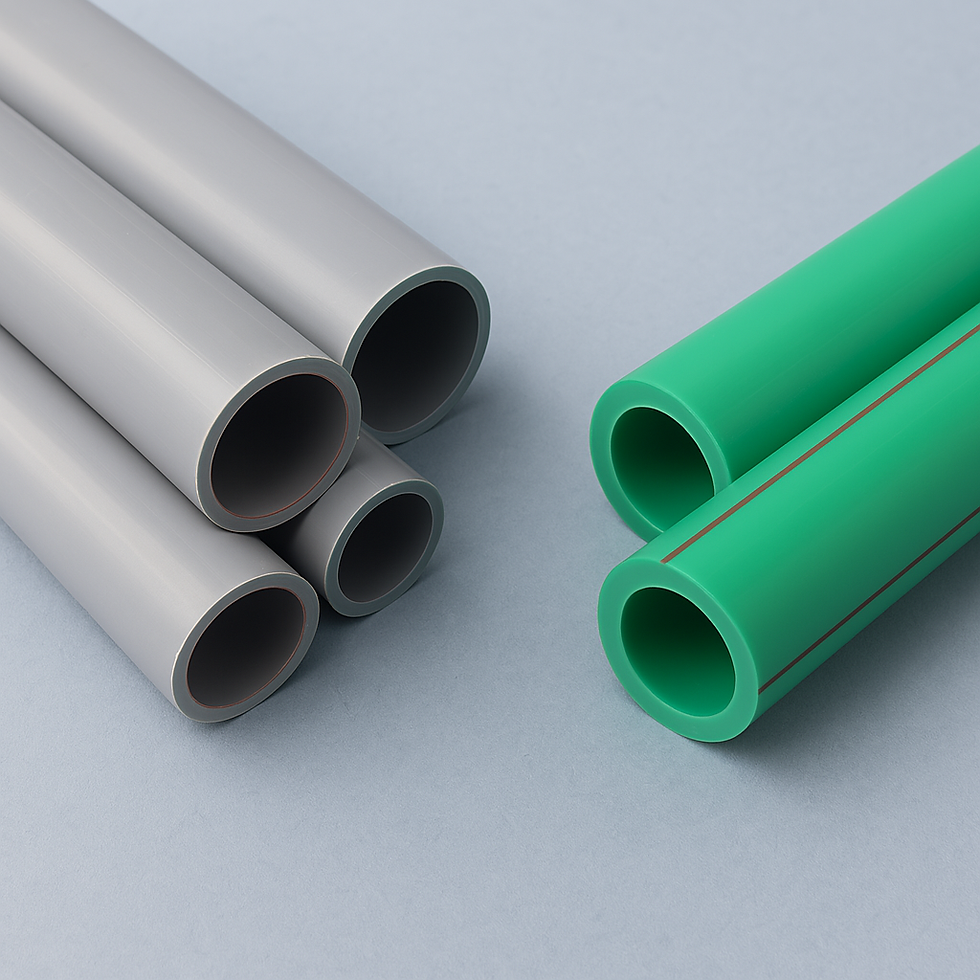From PVC to PEX: A Comprehensive Guide to Types of Plastic Pipes
- Adamjee DuraBuilt
- Jul 31, 2023
- 3 min read

Plastic pipes come in an extensive variety of choices, from PVC to PEX, and have completely changed the plumbing industry. Increasingly more people are using plastic pipes because of their adaptability, toughness, and affordability. Different types of plastic pipes have arisen to meet varied plumbing needs as innovations in materials and production methods continue to encourage development. Making informed judgments for plumbing projects necessitates having a thorough awareness of the distinctive qualities and benefits of each type of plastic pipe, whether it be for residential, commercial, or industrial uses.
The various types of plastic pipes, such as Polyvinyl Chloride (PVC), Cross-linked Polyethylene (PEX), High-Density Polyethylene (HDPE), Chlorinated Polyvinyl Chloride (CPVC), and Polypropylene Random Copolymer (PPRC) pipes, will be thoroughly discussed in this comprehensive guide, along with their uses in the plumbing industry.
Polyvinyl Chloride (PVC) Pipes
PVC also referred to as polyvinyl chloride, is one of the most popular forms of plastic pipes in the plumbing business. PVC pipes are renowned for being inexpensive, adaptable, and simple to install. These pipes are appropriate for a variety of uses, including irrigation, drainage, and water delivery systems. PVC pipes' smooth interior surfaces guarantee efficient water flow free of challenges, minimizing pressure loss. PVC pipes are a sturdy option for both indoor and outdoor plumbing projects due to their resistance to corrosion, chemicals, and UV radiation.
Cross-linked Polyethylene (PEX) Pipes
Another kind of plastic pipe that is becoming more and more well-liked in the plumbing industry is cross-linked polyethylene or PEX pipes. Because of their famed flexibility and adaptability, PEX pipes are perfect for usage in confined locations or around corners. The ability of PEX pipes to survive freezing is one of their main benefits, making them ideal for cold areas. They are also resistant to corrosion, which puts rust and scale worries to rest. Radiant floor heating, hydronic heating, and potable water delivery systems all frequently include PEX pipes.
High-Density Polyethylene (HDPE) Pipes
HDPE pipes, also known as high-density polyethylene pipes, are renowned for their amazing durability, strength, and chemical resistance. Several industries, including mining, agriculture, and municipal water delivery, use these pipes extensively. HDPE pipes are ideal for both above-ground and underground applications and can handle high pressures. They are portable and lightweight, making it simple to transfer and install them. HDPE pipes may be recycled and reused, which helps to promote ecologically responsible waste management techniques.
Chlorinated Polyvinyl Chloride (CPVC) Pipes
The PVC pipe version known as chlorinated polyvinyl chloride, or CPVC, is made primarily for hot water applications. CPVC pipes will survive higher temperatures than regular PVC pipes since they are heat-resistant. For the supply of hot water, they are frequently utilized in plumbing systems in homes and businesses. The smooth internal surface of CPVC pipes and resistance to corrosion provides effective water flow. CPVC pipes are a useful addition to plumbing systems in buildings and enterprises since they can handle hot water.
Polypropylene Random Copolymer (PPRC) Pipes
Plastic pipes known as Polypropylene Random Copolymer, or PPRC pipes, excel in both heat and chemical resistance. PPRC pipes are frequently utilized in heating applications as well as hot and cold water supply systems. Because of their small weight, these pipes are simple to handle and install. PPRC pipes have an inner surface that is smooth and corrosion-resistant, ensuring a steady flow of water. They are a trustworthy option for many plumbing requirements because of their capacity to tolerate high temperatures and pressures.
Conclusion
Every plumbing project requires careful consideration when selecting the type of plastic pipe. Each variety of plastic pipe has particular benefits and uses that are tailored to particular demands and needs. While PEX pipes excel in flexibility and freezing resistance, PVC pipes are more affordable and versatile. CPVC pipes are ideal for hot water applications, while HDPE pipes have great strength and chemical resistance. PPRC pipes are appropriate for hot and cold water delivery systems because of their thermal and chemical resistance. You may choose wisely for your plumbing projects by being aware of the features and advantages of each type of plastic pipe, assuring durable and dependable performance.












Comments